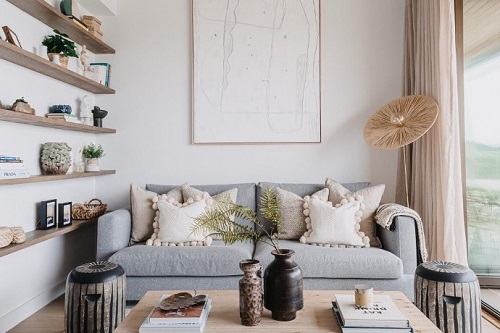Getting Organized Doesn’t Mean Being Perfect
By Pamela Wong
Pamela is a Trained Professional Organizer based in Oakville, Ontario and is the owner of Zen N Organized. She helps homeowners and small business owners transform their homes and home offices into organized spaces. She has a practical, non-judgemental approach to organizing. Her objective is to create functional and harmonious spaces for her clients.

In the age of social media, it’s easy to believe that “organized” means every pantry jar has a matching label, every closet is color-coded, and every surface sparkles like a magazine photo shoot. You scroll through Instagram and see homes where everything seems perfectly in its place — serene, minimal, and photo-ready. Then you look around your own home — with work files on the kitchen counter, backpacks by the door, and a few piles that seem to regenerate overnight — and wonder, “Why doesn’t mine look like that?”
Here’s the truth: getting and staying organized doesn’t mean your home needs to look “Instagram-ready.” It means your home should work for you — not for social media. For professional moms between 40 and 60, juggling work, family, and life, an organized space should feel functional, calm, and easy to maintain — not picture-perfect.
Let’s explore why being organized isn’t about appearances, what functional organization really means, and how to create spaces that make your life smoother — even if they’ll never go viral on social media.
The Problem with the “Instagram-Ready” Ideal
Instagram and Pinterest can be inspiring — but they also set unrealistic expectations. The homes you see online are often styled for photoshoots, not for real life. Everything is arranged with perfectly folded towels, matching baskets, and nothing out of place.
But what those photos don’t show are the realities of day-to-day living — kids who forget to hang up their jackets, the family pet shedding on the sofa, or the endless rotation of work, errands, and dinner prep that fills a busy household.
Here’s what happens when we chase that Instagram-ready look:
- We focus on appearance over function. Things look beautiful but may not be practical.
- We waste time and money. Matching containers, baskets, and bins can add up — fast.
- We feel like we’ve failed when things get messy again. But mess isn’t failure; it’s life happening.
A picture-perfect home isn’t a measure of success. A home that supports you, reduces stress, and helps you live comfortably — that’s the real goal.
What a Functional Organized Space Really Looks Like
A truly organized space doesn’t have to be minimalist or staged. It should be:
- Easy to use. You can find what you need without digging or guessing.
- Easy to maintain. Putting things away takes little effort and makes sense to everyone in the household.
- Tailored to your lifestyle. The system fits your routines — not someone else’s.
That might mean:
- Using mismatched containers that work well, instead of perfectly matching ones that don’t.
- Keeping a few items on your kitchen counter because you use them daily.
- Having open shelving in your mudroom where kids can toss their shoes easily.
It’s not about creating a showroom; it’s about creating flow.
The Emotional Side of “Real-Life” Organization
Many professional women and small business owners are balancing careers, supporting aging parents, managing teenagers or young adults, and trying to carve out time for themselves. With so much on your plate, your home should be a place that nurtures you, not adds pressure.
If you constantly compare your home to what you see online, it can lead to guilt, shame, or frustration — even though your home is serving you perfectly well. Organization isn’t about perfection; it’s about peace of mind.
Ask yourself:
- Can I find what I need when I need it?
- Does my home feel comfortable and calm?
- Can my family maintain the systems I’ve created?
If you can answer “yes” to those questions, your home is already organized — even if it wouldn’t pass an Instagram aesthetic test.
How to Create a Functional (Not Flawless) Home
- Start with your pain points, not your Pinterest board.
Ask: What’s not working in my home right now? Maybe the kitchen counters attract clutter, or you can’t find keys in the morning. Fix those problems first. Real organization begins with solving everyday frustrations, not achieving a specific “look.”
- Use what you already have.
Before buying anything new, see if baskets, trays, or bins you already own can serve a purpose. You don’t need matching acrylic containers for your pantry — sturdy Tupperware and well-labeled jars can do the job just as well.
- Label for clarity, not aesthetics.
Labels are helpful, but they don’t need to be calligraphed or vinyl-cut. A simple handwritten label is just as effective — and far quicker.
- Make systems simple and sustainable.
The more steps involved in putting something away, the less likely it will stick. For example, instead of a complex filing system, try a labeled basket for each family member’s papers or mail.
- Accept that “lived-in” is normal.
Homes evolve as families grow and schedules change. You’ll always have moments of mess — laundry day, meal prep, a busy workweek. That’s not disorganization; it’s life.
- Prioritize visibility over uniformity.
If you can’t see it, you won’t use it. Open bins, clear containers, and shelves can make your life easier — even if they don’t look uniform or minimalist.
- Involve your family.
An organized home isn’t a one-person show. Make sure systems are intuitive for everyone — that way, maintenance becomes a shared effort, not your burden.
Why Function Will Always Win
Imagine two kitchens:
- One looks perfect — labeled jars, empty counters — but you can’t remember where the spices are.
- The other is a bit eclectic, with everyday items within reach, and you can cook dinner without missing a beat.
Which one sounds more organized to you?
Function beats aesthetics every time because it makes your day easier. You’ll spend less time searching for things, cleaning up, and managing chaos — and more time doing what matters most.
When a system truly works, your home supports you. It reduces stress, saves time, and gives you space to breathe.
Give Yourself Permission to Let “Perfect” Go
Organization is not a performance; it’s a practice. It’s not about achieving a flawless look — it’s about creating calm and control in your daily life.
You don’t owe anyone a spotless home tour. What matters is that you feel comfortable, your family can function easily, and your home brings you a sense of peace rather than pressure.
An organized home can feel welcoming and functional without looking staged.
So the next time you scroll past a perfectly styled pantry or color-coded closet, remind yourself: that’s not the goal. Your goal is a space that supports your real life — the one with morning rushes, late dinners, and weekends full of family laughter.
Getting and staying organized isn’t about being Instagram-ready. It’s about being life-ready.
If your home helps you start your mornings calmly, end your days peacefully, and manage your family’s busy routines — congratulations. You’re already organized. And that’s something worth celebrating — no filter required.


